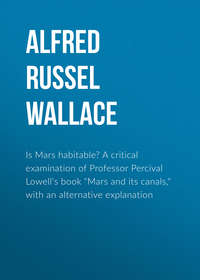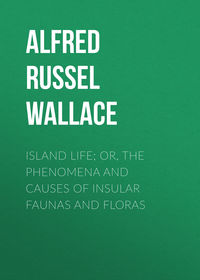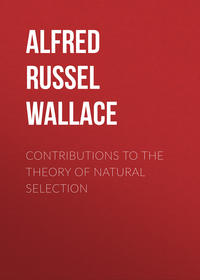 полная версия
полная версияПолная версия
Man's Place in the Universe
Although it has been admitted by the late Mr. Proctor and some other astronomers that most of the planets are not now habitable, yet, it is often urged, they may have been so in the past or may become so in the future. Some are now too hot, others are now too cold; some have now no water, others have too much; but all go through their appointed series of stages, and during some of these stages life may be or may have been possible. This argument, although vague, will appeal to some readers, and it may, therefore, be necessary to reply to it. This is the more necessary as it is still made use of by astronomers. In a criticism of my article in The Fortnightly Review, M. Camille Flammarion, of the Paris Observatory, dramatically remarks: 'Yes, life is universal, and eternal, for time is one of its factors. Yesterday the moon, to-day the earth, to-morrow Jupiter. In space there are both cradles and tombs.'19
It is thus suggested that the moon was once inhabited and that Jupiter will be inhabited in some remote future; but no attempt is made to deal with the essential physical conditions of these very diverse objects, rendering them not only now, but always, unfitted to develop and to maintain terrestrial or aerial life. This vague supposition—it can hardly be termed an argument—as regards past or future adaptability for life, of all the planets and some of the satellites in the solar system, is, however, rendered invalid by an equally general objection to which its upholders appear never to have given a moment's consideration; and as it is an objection which still further enforces the view as to the unique position of the earth in the solar system, it will be well to submit it to the judgment of our readers.
Limitation of the Sun's HeatIt is well known that there is, and has been for nearly half a century, a profound difference of opinion between geologists and physicists as to the actual or possible duration in years of life upon the earth. The geologists, being greatly impressed with the vast results produced by the slow processes of the wearing away of the rocks and the deposit of the material in seas or lakes, to be again upheaved to form dry land, and to be again carved out by rain and wind, by heat and cold, by snow and ice, into hills and valleys and grand mountain ranges; and further, by the fact that the highest mountains in every part of the globe very often exhibit on their loftiest summits stratified rocks which contain marine organisms, and were therefore originally laid down beneath the sea; and, yet again, by the fact that the loftiest mountains are often the most recent, and that these grand features of the earth's surface are but the latest examples of the action of forces that have been at work throughout all geological time—studying all their lives the detailed evidences of all these changes, have come to the conclusion that they imply enormous periods only to be measured by scores or hundreds of millions of years.
And the collateral study of fossil remains in the long series of rock-formations enforces this view. In the whole epoch of human history, and far back into prehistoric times during which man existed on the earth, although several animals have become extinct, yet there is no proof that any new one has been developed. But this human era, so far as yet known, going back certainly to the glacial epoch and almost certainly to pre-glacial times, cannot be estimated at less than a million, some think even several million years; and as there have certainly been some considerable alterations of level, excavation of valleys, deposits of great beds of gravel, and other superficial changes during this period, some kind of a scale of measurement of geological time has been obtained, by comparison with the very minute changes that have occurred during the historical period. This scale is admittedly a very imperfect one, but it is better than none at all; and it is by comparing these small changes with the far greater ones which have occurred during every successive step backward in geological history that these estimates of geological time have been arrived at. They are also supported by the palæontologists, to whom the vast panorama of successive forms of life is an ever-present reality. Directly they pass into the latest stage of the Tertiary period—the Pliocene of Sir Charles Lyell—all over the world new forms of life appear which are evidently the forerunners of many of our still existing species; and as they go a little further back, into the Miocene, there are indications of a warmer climate in Europe, and large numbers of mammals resembling those which now inhabit the tropics, but of quite distinct species and often of distinct genera and families. And here, though we have only reached to about the middle of the Tertiary period, the changes in the forms of life, in the climate, and in the land-surfaces are so great when compared with the very minute changes during the human epoch, as to require us to multiply the time elapsed many times over. Yet the whole of the Tertiary period, during which all the great groups of the higher animals were developed from a comparatively few generalised ancestral forms, is yet the shortest by far of the three great geological periods—the Mesozoic or Secondary, having been much longer, with still vaster changes both in the earth's crust and in the forms of life; while the Palæozoic or Primary, which carries us back to the earliest forms of life as represented by fossilised remains, is always estimated by geologists to be at least as long as the other two combined, and probably very much longer.
From these various considerations most geologists who have made any estimates of geological time from the period of the earliest fossiliferous rocks, have arrived at the conclusion that about 200 millions of years are required. But from the variety of the forms of life at this early period it is concluded that a very much greater duration is needed for the whole epoch of life. Speaking of the varied marine fauna of the Cambrian period, the late Professor Ramsay says:—'In this earliest known varied life we find no evidence of its having lived near the beginning of the zoological series. In a broad sense, compared with what must have gone before, both biologically and physically, all the phenomena connected with this old period seem, to my mind, to be of quite a recent description; and the climates of seas and lands were of the very same kind as those the world enjoys at the present day.' And Professor Huxley held very similar views when he declared: 'If the very small differences which are observable between the crocodiles of the older Secondary formations and those of the present day furnish any sort of an approximation towards an estimate of the average rate of change among reptiles, it is almost appalling to reflect how far back in Palæozoic times we must go before we can hope to arrive at that common stock from which the crocodiles, lizards, Ornithoscelida, and Plesiosauria, which had attained so great a development in the Triassic epoch, must have been derived.'
Now, in opposition to these demands of the geologists, in which they are almost unanimous, the most celebrated physicists, after full consideration of all possible sources of the heat of the sun, and knowing the rate at which it is now expending heat, declare, with complete conviction, that our sun cannot have existed as a heat-giving body for so long a period, and they would therefore reduce the time during which life can possibly have existed on the earth to about one-fourth of that demanded by geologists. In one of his latest articles, Lord Kelvin says:—'Now we have irrefragable dynamics proving that the whole life of our sun as a luminary is a very moderate number of million years, probably less than 50 million, possibly between 50 and 100' (Phil. Mag., vol. ii., Sixth Ser., p. 175, Aug. 1901). In my Island Life (chap. X.) I have myself given reasons for thinking that both the stratigraphical and biological changes may have gone on more quickly than has been supposed, and that geological time (meaning thereby the time during which the development of life upon the earth has been going on) may be reduced so as possibly to be brought within the maximum period allowed by physicists; but there will certainly be no time to spare, and any planets dependent on our sun whose period of habitability is either past or to come, cannot possibly have, or have had, sufficient time for the necessarily slow evolution of the higher life-forms. Again, all physicists hold that the sun is now cooling, and that its future life will be much less than its past. In a lecture at the Royal Institution (published in Nature Series, in 1889), Lord Kelvin says:—'It would, I think, be exceedingly rash to assume as probable anything more than twenty million years of the sun's light in the past history of the earth, or to reckon more than five or six million years of sunlight for time to come.'
These extracts serve to show that, unless either geologists or physicists are very far from any approach to accuracy in their estimates of past or future age of the sun, there is very great difficulty in bringing them into harmony or in accounting for the actual facts of the geological history of the earth and of the whole course of life-development upon it. We are, therefore, again brought to the conclusion that there has been, and is, no time to spare; that the whole of the available past life-period of the sun has been utilised for life-development on the earth, and that the future will be not much more than may be needed for the completion of the grand drama of human history, and the development of the full possibilities of the mental and moral nature of man.
We have here, then, a very powerful argument, from a different point of view than any previously considered, for the conclusion that man's place in the solar system is altogether unique, and that no other planet either has developed or can develop such a full and complete life-series as that which the earth has actually developed. Even if the conditions had been more favourable than they are seen to be on other planets, Mercury, Venus, and Mars could not possibly have preserved equability of conditions long enough for life-development, since for unknown ages they must have been passing slowly towards their present wholly unsuitable conditions; while Jupiter and the planets beyond him, whose epoch of life-development is supposed to be in the remote future when they shall have slowly cooled down to habitability, will then be still more faintly illuminated and scantily warmed by a rapidly cooling sun, and may thus become, at the best, globes of solid ice. This is the teaching of science—of the best science of the twentieth century. Yet we find even astronomers who, more than any other exponents of science, should give heed to the teachings of the sister sciences to which they owe so much, indulging in such rhapsodies as the following:—'In our solar system, this little earth has not obtained any special privileges from Nature, and it is strange to wish to confine life within the circle of terrestrial chemistry.' And again: 'Infinity encompasses us on all sides, life asserts itself, universal and eternal, our existence is but a fleeting moment, the vibration of an atom in a ray of the sun, and our planet is but an island floating in the celestial archipelago, to which no thought will ever place any bounds.'20
In place of such 'wild and whirling words,' I have endeavoured to state the sober conclusions of the best workers and thinkers as to the nature and origin of the world in which we live, and of the universe which on all sides surrounds us. I leave it to my readers to decide which is the more trustworthy guide.
CHAPTER XV
THE STARS—HAVE THEY PLANETARY SYSTEMS? ARE THEY BENEFICIAL TO US?Most of the writers on the Plurality of Worlds, from Fontenelle to Proctor, taking into consideration the enormous number of the stars and their apparent uselessness to our world, have assumed that many of them must have systems of planets circling round them, and that some of these planets, at all events, must possess inhabitants, some, perhaps, lower, but others no doubt higher than ourselves. One of our well-known modern astronomers, writing only ten years ago, adopts the same view. He says: 'The suns which we call stars were clearly not created for our benefit. They are of very little practical use to the earth's inhabitants. They give us very little light; an additional small satellite—one considerably smaller than the moon—would have been much more useful in this respect than the millions of stars revealed by the telescope. They must therefore have been formed for some other purpose.... We may therefore conclude, with a high degree of probability, that the stars—at least those with spectra of the solar type—form centres of planetary systems somewhat similar to our own.'21 The author then discusses the conditions necessary for life analogous to that of our earth, as regards temperature, rotation, mass, atmosphere, water, etc., and he is the only writer I have met with who has considered these conditions; but he touches on them very briefly, and he arrives at the conclusion that, in the case of the stars of solar type, it is probable that one planet, situated at a proper distance, would be fitted to support life. He estimates roughly that there are about ten million stars of this type, that is, closely resembling our sun, and that if only one in ten of these has a planet at the proper distance and properly constituted in other respects, there will be one million worlds fitted for the support of animal life. He therefore concludes that there are probably many stars having life-bearing planets revolving round them.
There are, however, many considerations not taken account of by this writer which tend to reduce very considerably the above estimate. It is now known that immense numbers of the stars of smaller magnitudes are nearer to us than are the majority of the stars of the first and second magnitudes, so that it is probable that these, as well as a considerable proportion of the very faint telescopic stars, are really of small dimensions. We have evidence that many of the brightest stars are much larger than our sun, but there are probably ten times as many that are much smaller. We have seen that the whole of the past light and heat-giving duration of our sun has, according to the best authorities, been only just sufficient for the development of life upon the earth. But the duration of a sun's heat-giving power will depend mainly upon its mass, together with its constituent elements. Suns which are much smaller than ours are, therefore, from that cause alone, unsuited to give adequate light and heat for a sufficient time, and with sufficient uniformity, for life-development on planets, even if they possess any at the right distance, and with the extensive series of nicely adjusted conditions which I have shown to be necessary.
Again, we must, probably, rule out as unfitted for life-development the whole region of the Milky Way, on account of the excessive forces there in action, as shown by the immense size of many of the stars, their enormous heat-giving power, the crowding of stars and nebulous matter, the great number of star-clusters, and, especially, because it is the region of 'new stars,' which imply collisions of masses of matter sufficiently large to become visible from the immense distance we are from them, but yet excessively small as compared with suns the duration of whose light is to be measured by millions of years. Hence the Milky Way is the theatre of extreme activity and motion; it is comparatively crowded with matter undergoing continual change, and is therefore not sufficiently stable for long periods to be at all likely to possess habitable worlds.
We must, therefore, limit our possible planetary systems suitable for life-development, to stars situated inside the circle of the Milky Way and far removed from it—that is, to those composing the solar cluster. These have been variously estimated to consist of a few hundred or many thousand stars—at all events to a very small number as compared with the 'hundreds of millions' in the whole stellar universe. But even here we find that only a portion are probably suitable. Professor Newcomb arrives at the conclusion—as have some other astronomers—that the stars in general have a much smaller mass in proportion to the light they give than our sun has; and, after an elaborate discussion, he finally concludes that the brighter stars are, on the average, much less dense than our sun. In all probability, therefore, they cannot give light and heat for so long a period, and as this period in the case of our sun has only been just sufficient, the number of suns of the solar type and of a sufficient mass may be very limited. Yet further, even among stars having a similar physical constitution to our sun and of an equal or greater mass, only a portion of their period of luminosity would be suitable for the support of planetary life. While they are in process of formation by accretions of solid or gaseous masses, they would be subject to such fluctuations of temperature, and to such catastrophic outbursts when any larger mass than usual was drawn towards them, that the whole of this period—perhaps by far the longest portion of their existence—must be left out of the account of planet-producing suns. Yet all these are to us stars of various degrees of brilliancy. It is almost certain that it is only when the growth of a sun is nearly completed, and its heat has attained a maximum, that the epoch of life-development is likely to begin upon any planets it may possess at the most suitable distance, and upon which all the requisite conditions should be present.
It may be said that there are great numbers of stars beyond our solar cluster and yet within the circle of the Milky Way, as well as others towards the poles of the Milky Way, which I have not here referred to. But of these regions very little is known, because it is impossible to tell whether stars in these directions are situated in the outer portion of the solar cluster or in the regions beyond it. Some astronomers appear to think that these regions may be nearly empty of stars, and I have endeavoured to represent what seems to be the general view on this very difficult subject in the two diagrams of the stellar universe at pp. 300, 301. The regions beyond our cluster and above or below the plane of the Milky Way are those where the small irresolvable nebulæ abound, and these may indicate that sun-formation is not yet active in those regions. The two charts of Nebulæ and Clusters at the end of the volume illustrate, and perhaps tend to support this view.
Double and Multiple Star SystemsWe have already seen, in our sixth chapter, how rapid and extraordinary has been the discovery of what are termed spectroscopic binaries—pairs of stars so close together as to appear like a single star in the most powerful telescopes. The systematic search for such stars has only been carried on for a few years, yet so many have been already found, and their numbers are increasing so rapidly, as to quite startle astronomers. One of the chief workers in this field, Professor Campbell of the Lick Observatory, has stated his opinion that, as accuracy of measurement increases, these discoveries will go on till—'the star that is not a spectroscopic binary will prove to be the rare exception,'—and other astronomers of eminence have expressed similar views. But these close revolving star-systems are generally admitted to be out of the category of life-producing suns. The tidal disturbances mutually produced must be enormous, and this must be inimical to the development of planets, unless they were very close to each sun, and thus in the most unfavourable position for life.
We thus see that the result of the most recent researches among the stars is entirely opposed to the old idea that the countless myriads of stars all had planets circulating round them, and that the ultimate purpose of their existence was, that they should be supporters of life, as our sun is the supporter of life upon the earth. So far is this from being the case, that vast numbers of stars have to be put aside as wholly unfitted for such a purpose; and when by successive eliminations of this nature we have reduced the numbers which may possibly be available to a few millions, or even to a few thousands, there comes the last startling discovery, that the entire host of stars is found to contain binary systems in such rapidly increasing numbers, as to lead some of the very first astronomers of the day to the conclusion that single stars may someday be found to be the rare exception! But this tremendous generalisation would, at one stroke, sweep away a large proportion of the stars which other successive disqualifications had spared, and thus leave our sun, which is certainly single, and perhaps two or three companion orbs, alone among the starry host as possible supporters of life on some one of the planets which circulate around them.
But we do not really know that any such suns exist. If they exist we do not know that they possess planets. If any do possess planets these may not be at the proper distance, or be of the proper mass, to render life possible. If these primary conditions should be fulfilled, and if there should possibly be not only one or two, but a dozen or more that so far fulfil the first few conditions which are essential, what probability is there that all the other conditions, all the other nice adaptations, all the delicate balance of opposing forces that we have found to prevail upon the earth, and whose combination here is due to exceptional conditions which exist in the case of no other known planet—should all be again combined in some of the possible planets of these possibly existing suns?
I submit that the probability is now all the other way. So long as we could assume that all the stars might be, in all essentials, like our sun, it seemed almost ludicrous to suppose that our sun alone should be in a position to support life. But when we find that enormous classes like the gaseous stars of small density, the solar stars while increasing in size and temperature, the stars which are much smaller than our sun, the nebulous stars, probably all the stars of the Milky Way, and lastly that enormous class of spectroscopic doubles—veritable Aaron's rods which threaten to swallow up all the rest—that all these are for various reasons unlikely to have attendant planets adapted to develop life, then the probabilities seem to be enormously against there being any considerable number of suns possessing attendant habitable earths. Just as the habitability of all the planets and larger satellites, once assumed as so extremely probable as to amount almost to a certainty, is now generally given up, so that in speculating on life in stellar systems Mr. Gore assumes that only one planet to each sun can be habitable; in like manner it may, and I believe will, turn out, that of all the myriad stars, the more we learn about them, the smaller and smaller will become the scanty residue which, with any probability, we can suppose to illuminate and vivify habitable earths. And when with this scanty probability we combine the still scantier probability that any such planet will possess simultaneously, and for a sufficiently long period, all the highly complex and delicately balanced conditions known to be essential for a full life-development, the conception that on this earth alone has such development been completed will not seem so wildly improbable a conjecture as it has hitherto been held to be.
Are the Stars Beneficial to Us?When I suggested in my first publication on this subject that some emanations from the stars might be beneficial or injurious, and that a central position might be essential in order to render these emanations equable, one of my astronomical critics laughed the idea to scorn, and declared that 'we might wander into outer space without losing anything more serious than we lose when the night is cloudy and we cannot see the stars.'22 How my critic knows that this is so he does not tell us. He states it positively, with no qualification, as if it were an established fact. It may be as well to inquire, therefore, if there is any evidence bearing upon the point at issue.











